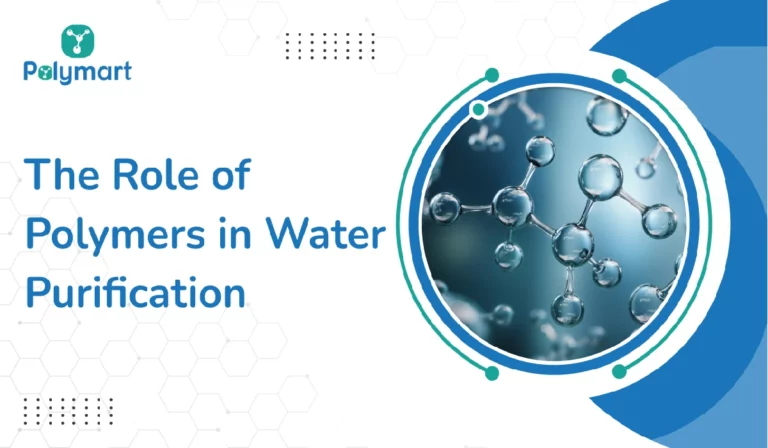Water is no longer just a utility—it’s a strategic asset. From regulatory compliance to operational efficiency and environmental sustainability, water management is central to industrial performance. As industries face mounting pressure to optimize water use and minimize waste, one class of materials is proving indispensable: functional polymers.
At the heart of modern water treatment, polymers act as highly efficient process aids—whether in clarifying turbid water, precipitating contaminants, or reducing sludge volumes. Their tailored performance, cost-effectiveness, and environmental benefits make them critical components across treatment chains in diverse sectors including manufacturing, textiles, food processing, and pharmaceuticals.
This blog explores the scientific role of polymers in water purification, breaking down their mechanisms, applications, and value across industries—and why PolyMart is your most reliable sourcing partner.
How Do Polymers Work in Water Treatment?
Polymers used in water treatment are long-chain organic molecules that either attract (flocculants) or neutralize (coagulants) suspended particles and dissolved impurities. Depending on the ionic charge—anionic, cationic, or non-ionic—they interact differently with contaminants, allowing targeted removal in specific treatment environments.
These compounds are engineered to optimize various physicochemical parameters such as:
- Molecular weight
- Charge density
- Solubility
- Reaction time in water
Key Benefits of Using Polymers in Water Treatment
1. Rapid Solid-Liquid Separation
Polymers enable faster sedimentation by aggregating fine particles into larger, settleable flocs. This improves the performance of primary and secondary clarifiers.
2. Reduced Chemical Footprint
Unlike conventional coagulants like alum or ferric salts, high-efficiency polymers require lower dosing volumes, reducing chemical consumption and sludge generation.
3. Enhanced Filtration Efficiency
By preventing membrane fouling and filter clogging, polymers extend the operational life of UF/RO membranes and sand filters.
4. Lower Sludge Volumes
Sludge treated with polymers dewaters more effectively, reducing hauling and disposal costs, and improving biosolid management.
5. Process Customization
Available in powder, liquid, and emulsion forms, polymers can be custom-formulated for specific contaminants—be it heavy metals, hydrocarbons, or bio-organic loads.
6. Regulatory Compliance & ESG Alignment
Polymer-treated water is more likely to meet CPCB and SPCB discharge norms. They also support sustainable practices such as wastewater recycling and zero-liquid discharge (ZLD).
Industry Applications of Polymers in Water Treatment
Municipal & Industrial Wastewater Treatment
Used in primary, secondary, and tertiary treatment phases for flocculation, dewatering, and sludge thickening.
Textile Industry
Removes residual dyes, surfactants, and sizing agents from high-COD wastewater.
Pulp & Paper
Separates lignin, ink particles, and fibrous waste from mill effluents, enhancing reuse in process loops.
Food & Beverage
Treats cleaning-in-place (CIP) water, removing oils, organic residues, and suspended particles, essential for hygiene compliance.
Pharma & Chemicals
Enables phase separation and toxicity reduction in highly complex effluents, often high in solvents, APIs, and salts.
Mining & Metallurgy
Clarifies wash water and reduces the turbidity of tailing ponds by settling fine particulates and neutralizing charges.
Power Generation
Prevents scale and particulate deposition in cooling towers and boilers, protecting infrastructure and conserving water.
Drinking Water Purification
Polymers assist in clarification and filtration in potable water plants, removing fine silt, pathogens, and NOM (natural organic matter).
Driving Sustainability with Polymers
Polymers are key enablers in circular water economy initiatives. By improving effluent quality and enabling water reuse, they help industries:
- Minimize freshwater intake
- Achieve zero-discharge targets
- Lower carbon footprints through efficient treatment cycles
Choosing the Right Polymer
Selection depends on:
- Wastewater characteristics (pH, COD, BOD, TSS)
- Plant configuration (batch vs continuous)
- Regulatory thresholds
- Final discharge or reuse requirement
Polymer types include:
- Cationic Flocculants (e.g., for sludge dewatering)
- Anionic Flocculants (e.g., for sedimentation)
- Non-Ionic Polymers (e.g., for neutral effluent streams)
- Polyamine and PolyDADMAC Coagulants (e.g., for colour and charge removal)
Source with Confidence — Only on PolyMart
If your business is looking to source high-performance polymers for water treatment or industrial processing, PolyMart is your trusted partner.
- Pan-India Sourcing: Tap into a robust network of verified suppliers
- Real-Time Pricing: Transparent, updated prices at your fingertips
- Reliable Logistics: Smooth, door-delivered material handling
- Grade Variety: Cationic, anionic, and non-ionic polymers available
- Technical Support: Find the right grade for your use-case
PolyMart is India’s fastest-growing digital platform for polymer distribution. We empower MSMEs and enterprises with smarter, more transparent procurement. Whether you’re running an ETP plant, managing ZLD compliance, or improving your ESG scores, PolyMart helps you procure exactly what you need, when you need it.

